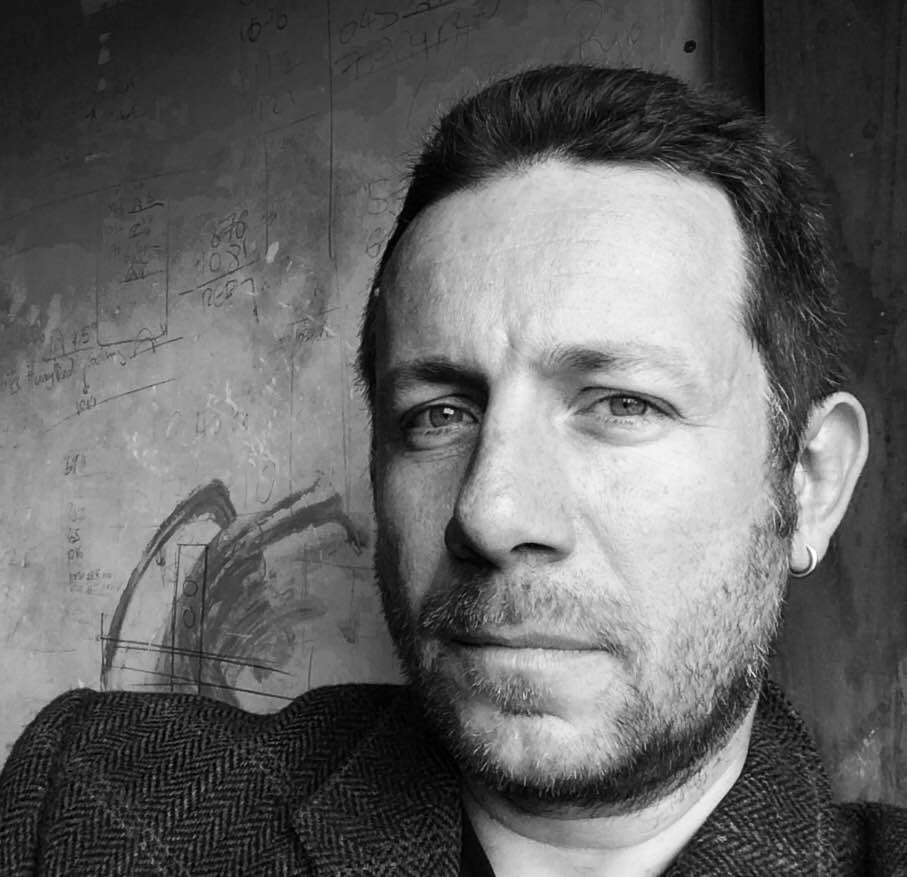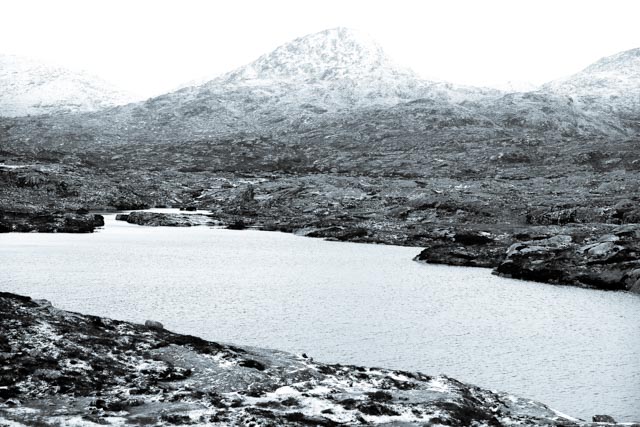
Nickolai Globe produces individual studio ceramics, influenced directly by the environment of the Isle of Harris. His new work takes ceramics to the edge of craft, where sculpture and function merge. His high fired stoneware bowls and vessel forms become geological and carry with them a deep reflection of the terrain of the Hebrides. Incorporating glass and raw minerals into his work they literally embody the landscape. Drawing from elements of Zen and the unpredictable, his work reflects, rather than emulates nature.

The Mission House studio, a converted church, where Nickolai & Beka Globe work, overlooks the desolate and stunning rocky landscape of the Bays of Harris. Beka’s beautiful black and white photographs float off the stone walls, suspended by high tensile wires. Nickolai’s ceramics ranging from functional stoneware to abstract sculptural forms are displayed on furniture, fashioned from old timber and reclaimed materials from the Church conversion. Ambient music reverberates through the space.
Would you please give us a potted autobiography?
Born into clay, played with it ever since, getting more and more serious the more I do!
Would you please describe the physical process of ceramic art? Would you call it sculpture – or something different?
Metamorphosis, creating artefacts or by-products from a process of exploration. The “WORKS” are as much questions as answers. I see myself as a participant and the objects I produce as inquiries. Finding objects that intrigue, ignite my curiosity on an intuitive, visceral level. Although there are many thoughts running through the process I allow ambiguity to balance out any preconceptions…
How do you select the raw material for your work? What are you looking for?
I am experimental, and I look for interesting reactions, mineral, glass, clay, metals – fusing elements, creating potentially new compounds, acting like the reactor of the physical universe, a random alchemy.

Do you only work with stone; if so would you consider any other medium?
I work with minerals, glass, clay, metals and in four dimensions, I fuse milliseconds of time, similar to photography, catching a physical moment, fusing in heat. Hold, dry – vitrify, transform. A four-dimensional calligraphy, a geological brush stroke. Frozen Time.
What is special about Harris in terms of geology?
Erosion, all laid bare, exposed, revealed and 3.6 billion year old ancient gneiss and anorthosite – with an identical composition to moon rock.
And for your work?
Space Time Continuum: –
Space to work, physical work space, head space, wide open land space.
Time to work slowly, to evolve, explore, go deeper…
Continuum – essential work flow, season cyclic rhythm, continuity

For your life?
Hermitage, work without interruption, distraction or zeitgeist, I thrive on the fringe of the continent, love the distant metropolis…. a bit of a bear in a cave!
We speak of the terroir signature in wine and food – what do you understand by that expression? Can a finished work of art also possess terroir and, if so, in what sense?
Distillation, extraction of essence, shaping of elements… I hope my work possesses its own sense of terroir, that it contains the essence of the land. Rock, island, Atlantic edge. It embodies its subject, physically resonates with it, it is made of the same stuff!
How much of your work is filtered through an aesthetic and how much is the creative process, also an emotional/spiritual one? To what extent do you detach or can you lose yourself totally within the creative process?
Curiosity and urge: to explore, shape, engage with the process, the metamorphosis and time. The transformation of material through intense heat is primal, yet at the same time scientific. There is a balance between the two extremes that keeps it interesting… not sure about “spiritual”… but I know I can’t help doing it!

How long does it take to make a piece? Do you put it away and keep coming back or is it a continuous process?
The process is a kind of “Event Horizon”. There is always a combination of the explosive immediate intense moment of formation, soft clay and fluid movement. Then comes slow time, where drying, weathering, ageing takes place, much as in wine where there is a maturing process. Finally, there is the fire, the flame burns, fluxes fuse, melt, and vitrify. The metamorphosis continues under different influences, high heat, hotter than a volcano, up to 1350 C. This part can take up to 24 hours, once, twice, sometimes three firings… After firing some pieces are then eroded, ground down, weathered… and destroyed. I am also creating a geological midden with my shards, their process continues…
Do you see any parallels between the process of winemaking (or rather being a vigneron) and a ceramic sculptor?
I have brewed beer, love to cook, never taken the opportunity (yet) to make wine, but in all these creative acts there are parallels.
The ingredients and their effects vary, but they all take time, practice, sensitivity, and a degree of creative courage. They require a direction, but a willingness to be led by the ingredients, the elements and the process. Ultimately the aim is to produce something that transports us as far as possible from the banal and quotidian.

How do you feel about your various pieces when you finish them? Do you have favourites? Do you detach from them – or are they still part of you somehow?
To let go is to finish with a piece. There is a clear moment in most cases with ceramics when a piece is finished or not and that is when it comes out of the fire. At this point I let go of it, and leave it to the world outside the studio to figure out, engage with, provoke…. I love to let go of my work as it creates momentum, creates space, paves the way for more explorations and experimentation, which is also what spurs me on. It also means I don’t have to “do another job” to survive. If I see a piece of work that I have created in the past, the memory of making it is always very clear. There is nothing lost in the letting go. There are many objects in the studio that remain just to inform and create conceptual connections between other things. They also act as reminders of tangents and avenues to explore. Starting points on the map, like a compass for the territory – the terroir….
How do you find that people respond to them? How would you like them to respond?
There is sometimes confusion at first “Are these supposed to be pots?” but then curiosity and intrigue. The materials’ qualities and their root in craft are comforting and familiar, yet my works have departed the domain of the domicile and functional. The bowl forms are very inviting, almost a trap, as they offer a purpose, an archaic function, with stone axe came vessel. My work is abstract, ambiguous, and works on a visceral level. It reveals itself over time.

We hear the term ‘wabi-sabi’ applied to ceramic sculpture. Would you describe the concept, particularly in relation to your art?
Transience, quietness, naturalness. A uniqueness that comes from process.
Wabi-sabi
An aesthetic centred on the acceptance of transience, described as one of beauty that is “imperfect, impermanent, and incomplete”. If an object or expression can bring about, within us, a sense of serene melancholy and a spiritual longing, then that object could be said to be wabi-sabi.
Referring to the loneliness of living in nature, remote from society it connotes rustic simplicity, freshness or quietness, and can be applied to both natural and human-made objects. It can also refer to quirks and anomalies arising from the process of construction, which add uniqueness and elegance to the object.
Wabi-sabi suggests sentiments of desolation and solitude.
Would you explain your love of wine? Where does it come from? If so, can you describe your feelings?
Deep and viscous love! It is for me an essential flux to open the sensory sluices. It feels like a soul food, it connects with an important part of me and, unlike other alcohols, it seems to open up other senses. Alongside food, music, visual stimuli, it makes me feel both connected yet disconnected at the same time. Immersing myself in sensory richness allows me to detach and switch off the me-in-me. As soul food goes, it is an immediate way of switching off after a day of being switched on with people and the world at large.

Have you ever had a wine epiphany, or similar transformative experience?
As far as epiphanies go I recall a peppery Mitchell Shiraz enjoyed with a seared fillet of kangaroo that could hardly be explained, it seemed like the essence of the blood red earth of Australia in meat and wine. We often butcher a wild red deer in the autumn and enjoy a big earthy Coonawarra with the fillet while doing so. It really does mark a seasonal shift, and that deep urge to prepare for the long dark winter ahead.
What sort of wines do you enjoy drinking? What qualities do you look for in wines or are you happy to be surprised?
I prefer my red wine to be big, meaty, friendly, fulfilling. Like an inner embrace from an old friend, a reassuring heart hug from the land. I love minerally whites that give you a kiss and a tongue bite at the same time, irresistibly sloshing them with seafood or with sheep and goat cheese, or Prosecco at any time of day with its salty light bite with anchovies, risotti and langoustines. I always look for something new as I do in my work. I prefer new world: Antipodean, South African, Australian and South American…. perhaps it is an antipodal desire for sunshine as I live in the far flung Outer Hebrides. I think there is also some connection with the sea, and living on the coast…

Do you respond to the pleasure given by a beautiful bottle of wine in the same way as you would to a painting, a piece of music and so forth? In what ways are the responses similar and in what ways are they different?
Synaesthesia…wine makes music, art and food come to life, the lines melt, there is cross–stimulation wherein the sensory centres get fired up and start talking to each other, fusing, overlapping and blending….shapes, textures, colours, words…I also think hedonism plays its part, the idea that pleasure is the highest good and the proper aim of human life. But things that open up the channels have surely got to be good for us!

